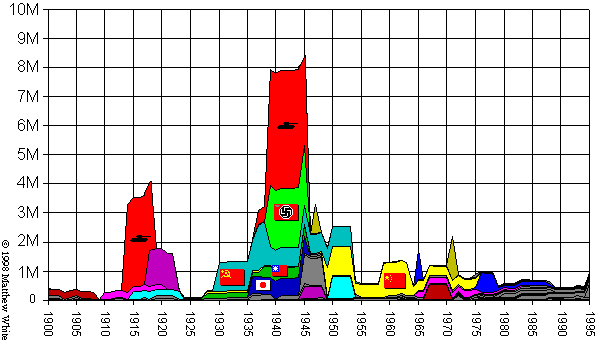stormthebeaches wrote: That's what I meant. A series of famines over a period of 150 years (not 200, that was my mistake) which resulted in 24 to 29 million deaths. The blog states that the first famine occurred in 1772 and the last famine was in 1927 so I'm drawing my conclusions from that.
Actually, Indian famines go much further back than that. For example there was a great famine in 1022-1023 that is believed to have killed around three million people; there was another in Deccan and Gujarat in the 1620s that killed another two million. The last major famines in India were in Bihar in 1966 and Maharashtra in 1973. So, famines both preceeded and post-dated the British occupation of India. It is hard, therefore to see the justification for holding the Brits responsible for them.
The real problem has been that there has always been a precarious balance between India's population and its food resources. That balance is easily disturbed and is, anyway, totally dependent on the Monsoon cycle. If the monsoon is late or it falls short in terms of total rainfall, then there is going to be a disaster. No ifs buts or maybes there. The sheer size of India and its population means that any disaster was going to kill a lot of people. Now, on average, the monsoon fails (ie is late and/or short) one year in twenty. One monsoon failure and there was a serious problem, two monsoon failures in quick succession and there is a Great Famine. That's the weather, pure and simple. It doesn't really matter who ruled the country
The other problem with India is its size. The projections used on maps understates this but India is big. It also had virtually no long-haul transport infrastructure. This is as much a problem today as it was a hundred years ago. Give you a simple example; because there is no long-haul freight transport system of any note, it's impossible to move raw materials around the countryside. This means that factories have to be built where the raw materials are. This means they produce their products close to teh sources of raw materials. Now, one of the primary raw materials sources is natural gas and this gets used, inter alia, for fertilizer production. So, we have large quantities of fertilizer being produced close to the natural gas fields which is largely where it isn't needed. So we have a fertilizer glut where we don't need it and we have a fertilizer shortage where it is needed.
This has a catastrophic effect on food production now and was much worse way back when. Food is a time sensitive bulk commodity; it's hard to transport in quantity and if it doesn't reach its destination quickly, it spoils and is wasted. This is particularly so in hot climates where (for example) milk can spoil in a few hours. So, it is extremely hard to counter a famine that takes place in one area by moving supplies in from another. In an era when the only bulk cargo transport medium was ox carts (average distance for an ox cart carrying a ton of cargo on reasonably good roads is 16 miles per day - and that assumes the oxen are grazing between pulls; if they have to be fed using fodder, you can work out how quickly they eat their cargo) mass movement of food supplies was impossible. So, it was quite possible for one region which got lucky in the monsoon lottery to have an excess of food bordering on abundance while another region as little as a hundred miles away which got unlucky has thousands dying of famine. And nobody could do anything about it.
This, by the way, is the explanation why India exported large quantities of food in the middle of famines. It's not perversity or deliberate slaughter, it's a reasonable response to trying to match a problem with a solution. India has no long haul transport medium; one can't, for example bring food from (say) Tamil Nadu to Kashmir. It would take weeks, months even. So, what one does is loads that excess food onto ships and sell it for hard cash. Then, one uses that hard cash to buy food elsewhere and bring it in. Remember, ox-cart 16 miles per day, merchant ship circa 200 miles per day. Maximum radius of transport for an ox-cart is around 160 miles, for a merchant ship it's several thousand miles.
The British initiated a break in this pattern by building railways, canals and other investments in infrastructure. They were weak (primarily due to the sheer amount of work that had to be done) but they did achieve a significant break in the dependence on the Monsoon Cycle. It is perfectly arguable that in other famines of the 19th century, the British did nothing to ameliorate the disaster but then nobody else had either and it's arguable that the British simply didn't know what to do. Famine on this scale was something they had never run into before and they applied measures that had worked in their own much smaller, much less severe and much more localized famines and those measures were found seriously wanting. It is notable that as British experience built up, they got more effective and the famines receded. Instead of killing millions, they killed hundreds of thousands. Then there were the Great Famines of 1917 and 1932 - oh, there weren't (there should have been; the Monsoons failed on schedule both years but famine was prevented in those years). In fact, there was no famine in India between 1896 and 1943 - and that is a major break in Indian history.
The last great famine was in 1943/44 in Bengal. The British can't really be blamed for it; it was a perfect storm of circumstances and everybody had a hand in it. Name a country and it was responsible somewhere. (Let's see; Germany - torpedoed British freighters causing a shipping shortage that prevented food being brought in. United States? Had lots of merchant ships but had a very inefficient way of using those ships that resulted in large numbers being used as little more than floating warehouses. Thus adding to the shipping shortage. Sometimes the links can be a bit strained but they're there).
The point I'm getting at is that famine in India is a very complicated issue and it has a lot of factors in it. It's always very easy to score cheap points by hugely oversimplifying these issues (and there is a distinct strain in academia that loves to do just that) but the reality is that the issues are very complex and require detailed studies of climate and transport infrastructure. Yes, if one takes the virtue that every death from famine in India was due to the British, one can rack up an impressive death toll. However, it is equally justifiable to add up the numbers of people who didn't die either because their (granted, fumbling and often inept but still existant) aid measures saved lives (in the Bihar famine of 1973-74 there was no significant mortality at all due to prompt and effective aid) or because their infrastructure developments prevented famines completely. Just taking the Bihar Famine and the early 20th century famines that never happened, one can argue that 18 million lives were "saved" in those three cases alone. Add in the reduction in death tolls due to other aid efforts and other famines that didn't happen and I bet I can make it look as if more lives were saved than lost.
No matter how one cuts it, a look at the British in India shows that tehy at least tried to do something about famines. None of their other predeccessors did - primarily because they couldn't.




